Welcome to CamundaCon 2025 Amsterdam!
We hope you’re as amped up as we are for CamundaCon 2025 Amsterdam—the first time CamundaCon has ever been to this great city—which kicks off online in mere minutes! Just like at the previous CamundaCon in New York City, we’ll be bringing you the latest updates from the event live as they’re happening. Be sure to check back frequently as we’ll be updating this post throughout the day.
If you couldn’t join in person in Amsterdam, many sessions are streaming live and it’s free to join online—so you can still catch the action! Just register at the link below, check out the agenda and make sure you don’t miss anything (be sure to filter by livestream). We’ll see you there, whether online or in person!
Update: CamundaCon 2025 Amsterdam has ended, but you can check out the videos (when available) so you don’t miss a thing!
The hackday and live masterclasses taking place in person in Amsterdam will be wrapping up shortly. The main event begins with the opening keynote at 12:30pm CEST / 6:30am ET. Stay tuned for more updates here!
For those of you at the hackday, you may have caught a glimpse of this svelte gentleman working the room. As always, Niall is here to help.

The countdown is on! Get excited, we’re about to begin here in Amsterdam.
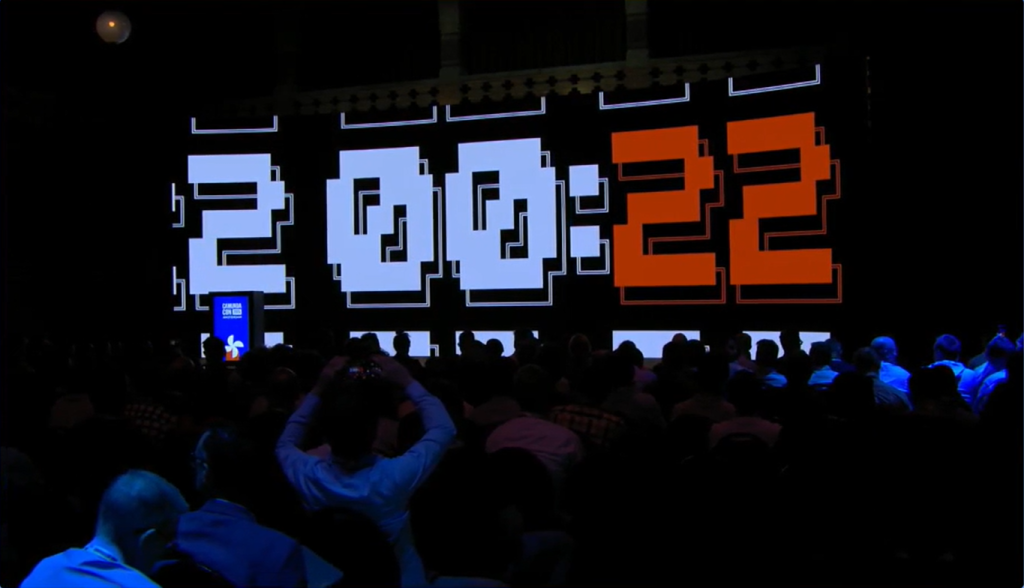
Welcome!
Camunda’s Amy Johnston welcome everyone to CamundaCon 2025 Amsterdam! Excited to be in Amsterdam for the first time in a historic building, Amy explained the traditional Camunda Selfie Screen (tag your selfies with #camundacon and #selfie to join!), the Camunda and sponsor booths, available silent disco-style demo presentations (listen with headphones as you grab a coffee), and of course how to access the WiFi and Slido for questions. Amy also covered our code of conduct and how you can fill out your “passport” with stickers to help us decide where charitable contributions we’ll be making will go.
Next up, she welcomed Camunda co-founder and CEO Jakob Freund to the stage.
Opening Keynote by Jakob Freund
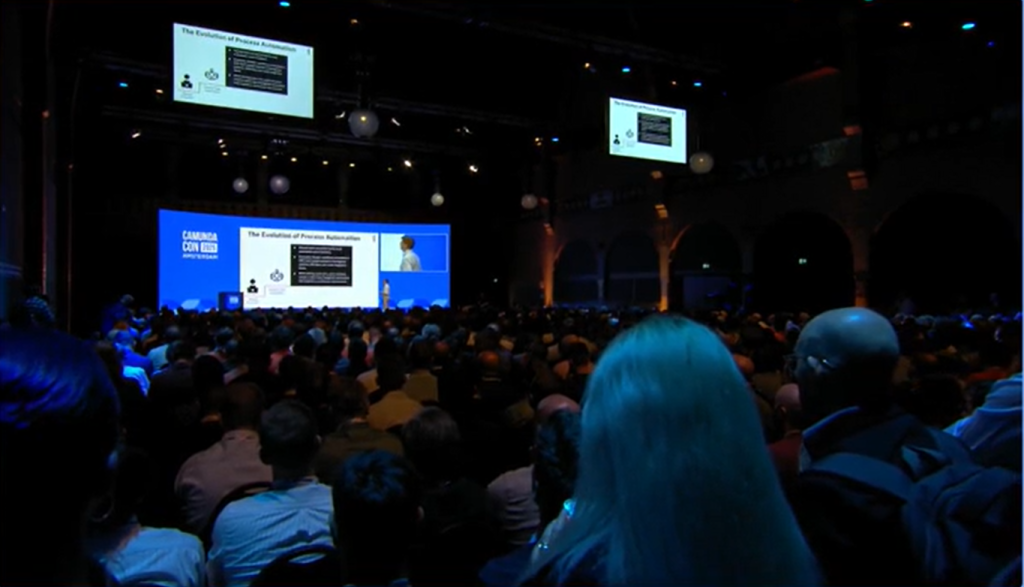
Jakob led off by thanking the absolutely packed room you can see above for attending, and then taking us through a brief history of the evolution of process automation. Essentially, in the early days, task automation was isolated and local, and created a value trap—quick wins that ended up leading to technical debt when organizations tried to modernize and eventually orchestrate the whole process.
Agentic orchestration
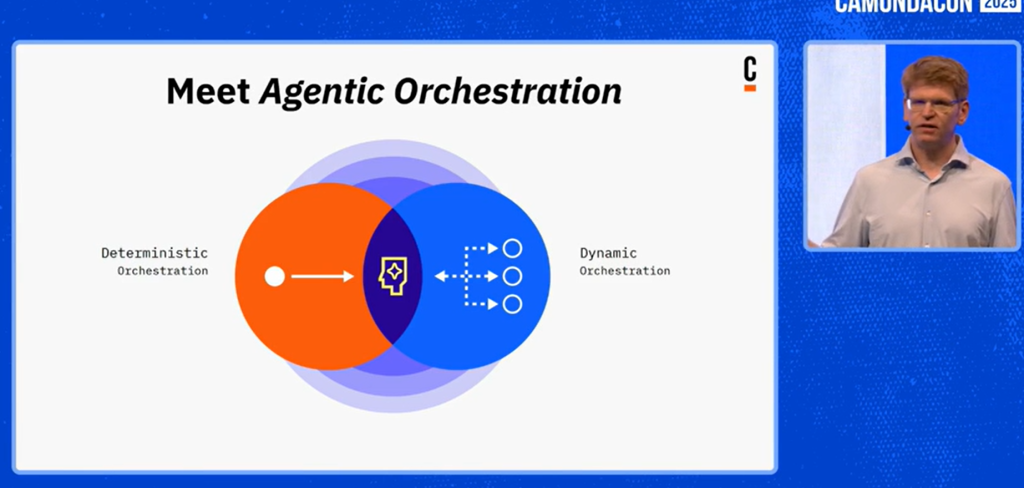
Camunda has always been about breaking you out of that value trap with end-to-end orchestration, and with the new ability to incorporate dynamic orchestration we can now take that approach much further. By combining deterministic orchestration (straight through with predefined rules) with dynamic orchestration (which is less structured and where an AI agent can make decisions), you get something new: agentic orchestration.
Trade reconciliation and the challenge of T+1
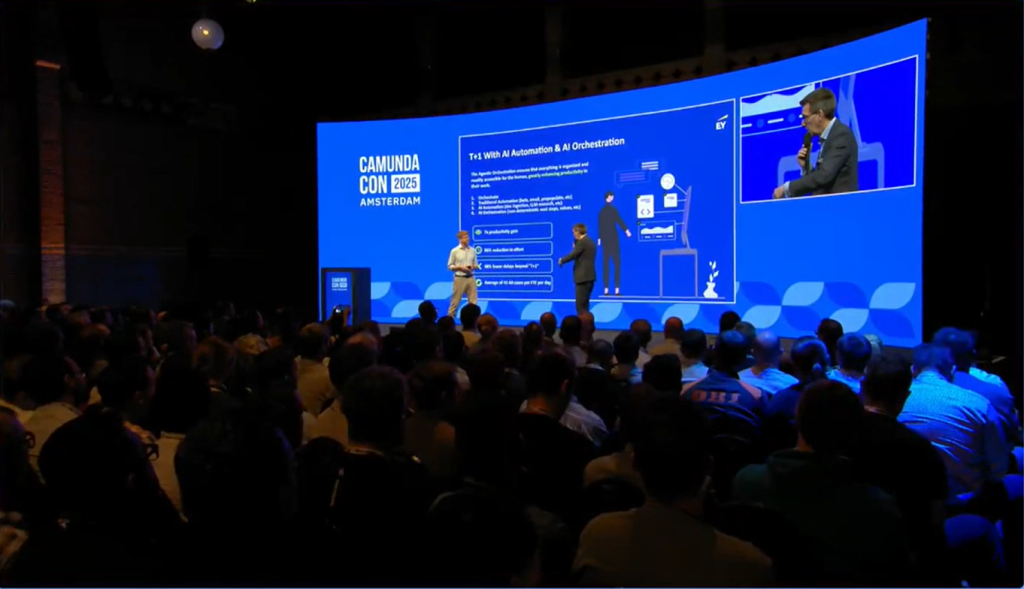
Jakob then invited Lars Tandrup, Partner/Principal at our partner EY, to talk about a solution to a difficult problem in financial services—reconciliation of trades. New regulations in the US mean this has to happen within 24 hours, and many companies have tens of thousands employees dedicated to tackling this manually today. Implementing agentic orchestration delivered a seven-fold (wow!) increase in the ability of users to handle trade reconciliations, and a 98% reduction in cases that go beyond T+1 (and would incur fines for being too slow). This is a powerful story, and Lars will be talking on a live streamed session later today to dig in deeper, definitely won’t be missing that one.
How agentic orchestration works in Camunda
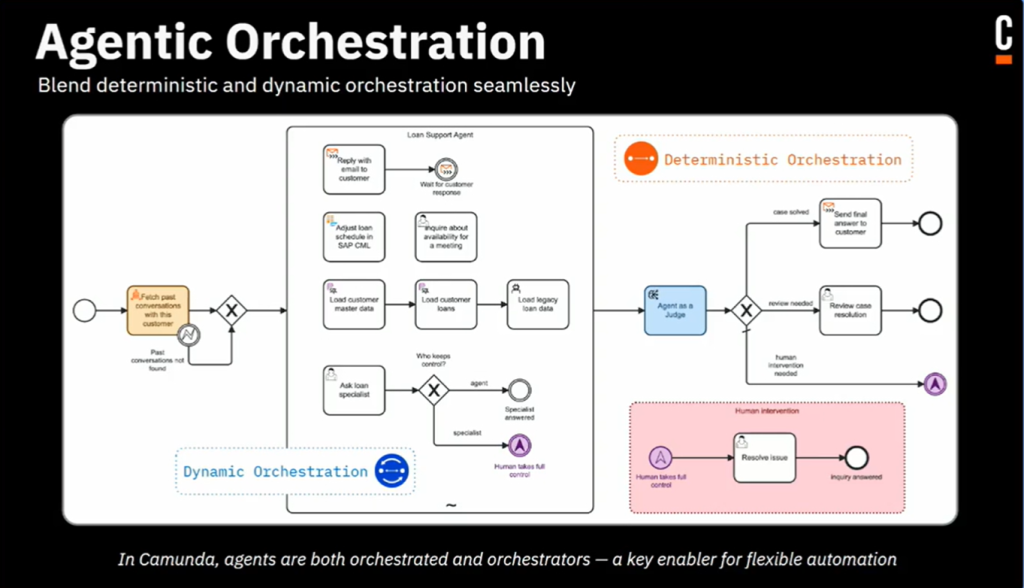
Daniel Meyer, Camunda’s CTO, then took the stage to showcase a little more of how agentic orchestration works behind the scenes. Dynamic orchestration is realized by agents and can change—which is different than simply incorporating AI into a deterministic process. In screenshots from a demo (which will be shown live tomorrow!), he explained how easily an LLM could, for example, send emails automatically based on unstructured user requests. But he also demonstrated the value of BPMN in how easily you could simply add a user task before the email goes out if you want a human to review first.
Then Daniel posed the question—so is there still a place for deterministic, straight-through processes? The answer is a resounding yes. For example, SIM card activation is a critical process for telecommunication companies, and the standard is that it is routinely completed in less than one minute. This is not a candidate for dynamic orchestration. However, exception handling is still a problem. When something goes wrong, the usual procedure is to kick out to a manual check. This is an agentic orchestration opportunity where it can still help.
Other examples
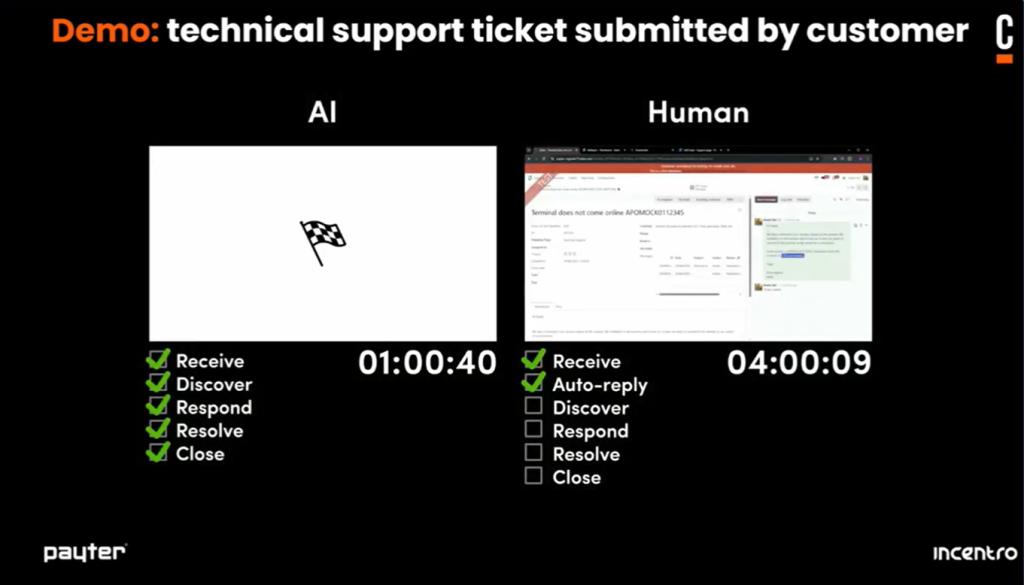
Several other speakers than demonstrated some fascinating examples. Andre Bal, Director of Supply Chain and Automation at Payter recently partnered with Edwin Nooijen, Partner Manager at Incentro to use agentic orchestration to reduce the workload for the humans and dramatically improve the service level to customers. Dr. Leander Fielder from NordLB spoke to how they created essentially an center of excellence for AI and realized the value of combining deterministic processes with dynamic processes along with humans in the loop to provide guardrails for AI. These are exciting stories of agentic orchestration already being used in the market today.
Don’t wait
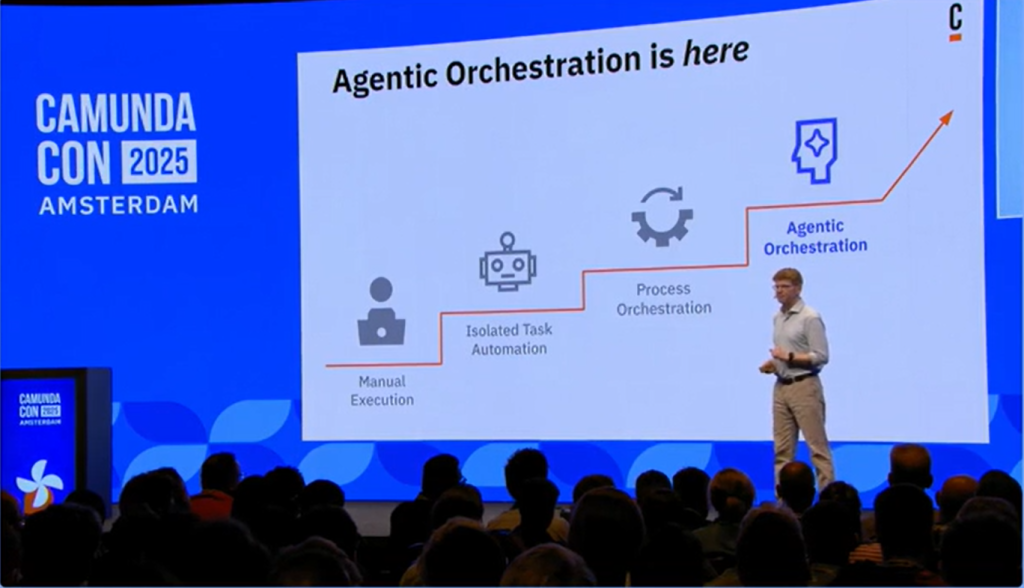
Jakob’s final message was not to wait. The autonomous enterprise of the future is coming, and agentic orchestration is not a pie in the sky. It’s here, today, and it’s only becoming more and more common and more powerful. Look into it, talk to us, and let’s see what we can do together.
Reinventing Fraud Detection: NatWest’s Journey to Operationalize AI with Camunda
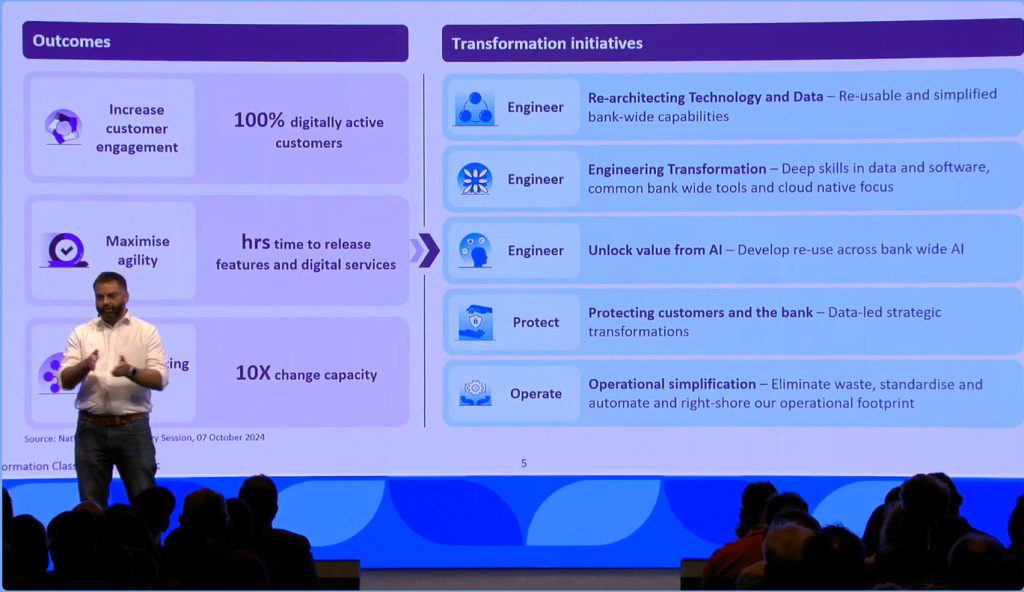
Joanne Barry, Head of Technology Fraud Prevention COE at NatWest and Milesh Chudasama, Digital Transformation Director at NatWest then talked about how NatWest is operationalizing AI for fraud detection and more. Milesh talked about the importance of an “opti-channel” mindset (rather than omni-channel), helping the customer to always get to the right channel at the right time.
Innovation by Cooperation | Rabobank’s approach on banking for the future
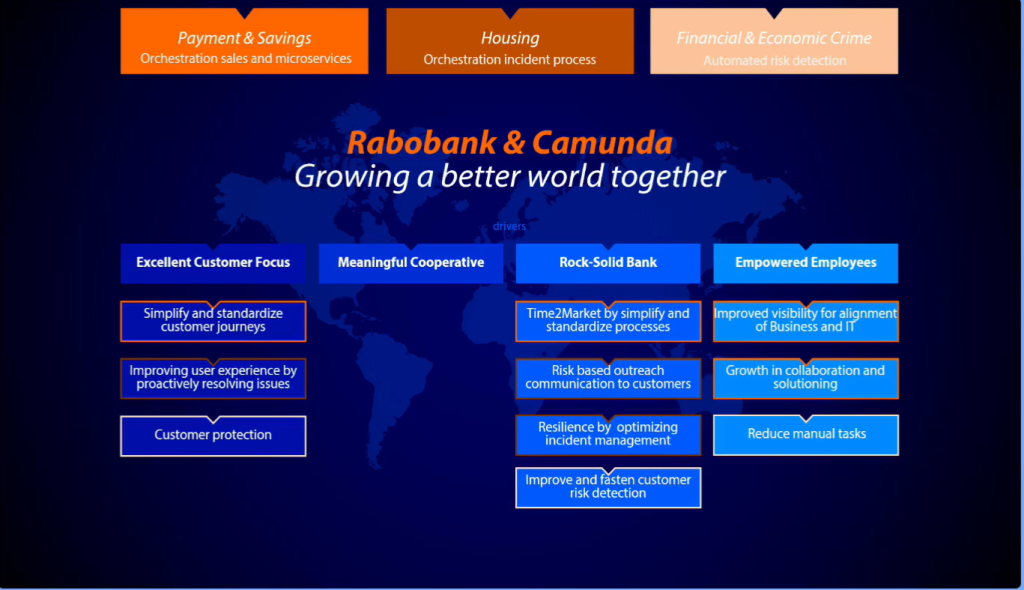
Fred van Pouderoijen, Head of Tech Payments & Savings at Rabobank next took the stage to talk about how they are using AI today. From copilots and chatbots for software development, operational efficiency, and customer service and more, Fred spoke about the benefits they are seeing today. In the future he sees a huge opportunity in using it to assist with anti-money laundering and KYC, as well as financial advising.
How HSBC redefines the customer journeys at scale with Camunda
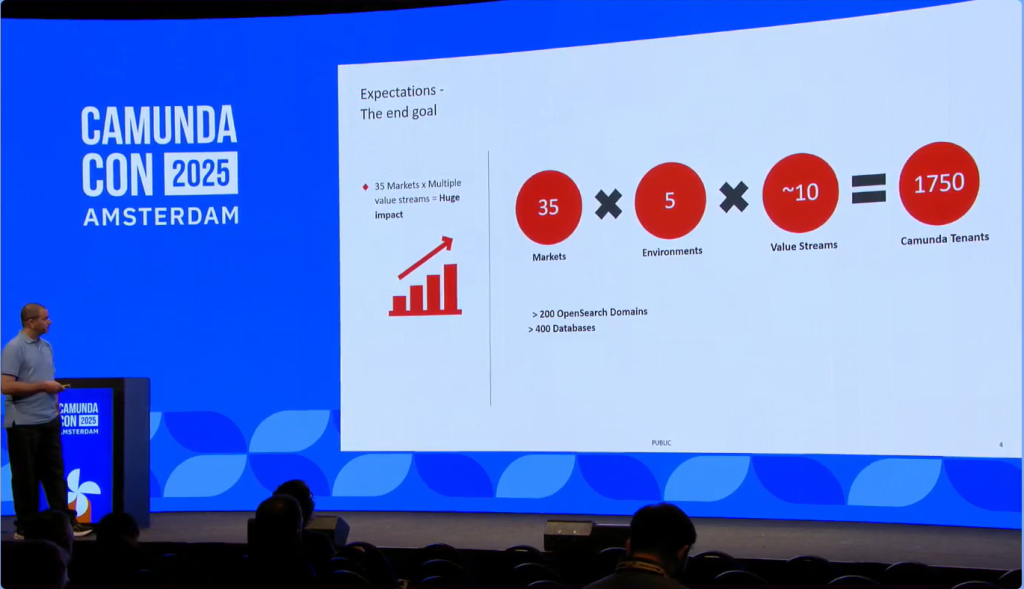
Dan Avidan, Lead Platform Architect at HSBC was up next to talk about how HSBC worked to improve their customer journey flow with process orchestration at a massive scale. HSBC is a large and global bank, with over $3 trillion in assets, over 41 million customers, and operating in 58 markets. Avidan took us through the complexity of their legacy structure and the challenge of needing to scale across a large global market.
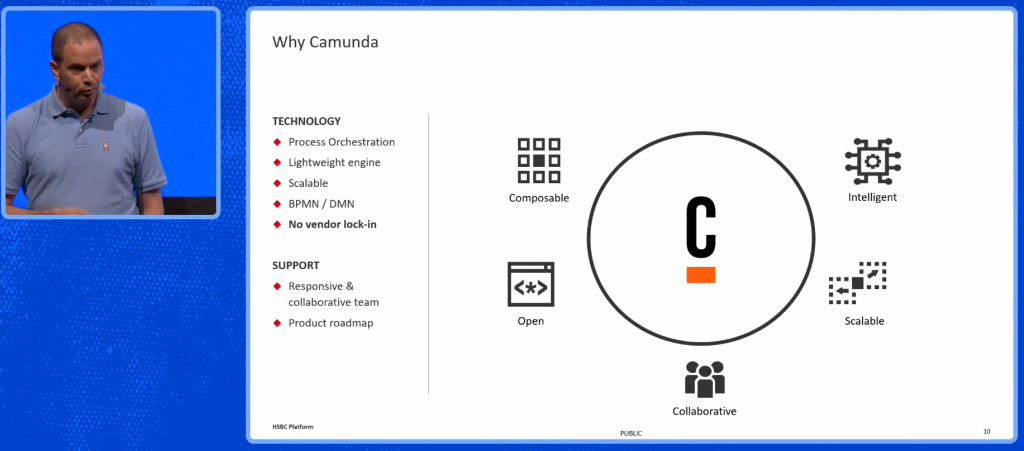
A key goal was empowering the business to do everything from designing, to monitoring, to optimizing and more. Avidan spoke about how two value stream use cases are already live with Camunda (with four more coming this year), how they have enabled BPMN usage across the company, and the infrastructure they have put into place to handle it. He also shared a lot of lessons learned, food for thought, and excitement around upgrading to 8.8 soon. Check out the full recording to see how a large, complex and highly regulated environment was able to simplify and gain huge efficiencies using Camunda.
ICYMI
- From Zero to Traffic: Rolling out carrier network with Swisscom and Camunda – Swisscom transports the major share of Switzerland’s internet traffic. In this session, which was not streamed but will have a recording available after the event (be sure to sign up to receive the link!), you’ll learn about both the high-level business processes, the low-level hardware requirements, and how Camunda was adopted by developers within the company.
- Hackday Presentations – These were also taking place along with the two talks above. While they are not recorded, in-person attendees were treated to many fine presentations as always, and we hope online readers enjoyed a taste of what the hackday was like above.
Digital transformation at Halkbank: Enhancing operational efficiency & customer experience with Camunda
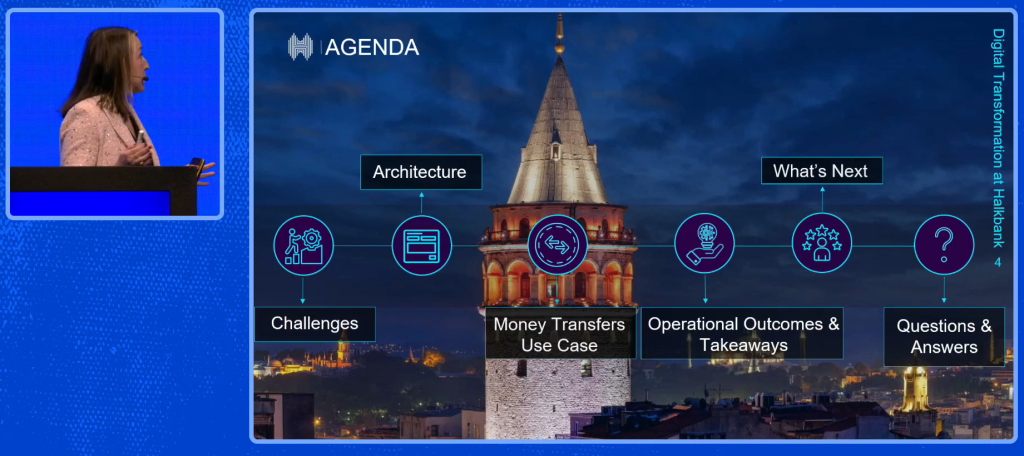
The next session was led by Gülefşan Yildirim Başaran, Unit Manager, Core Banking Software Development at Halkbank and Ibrahim Küp, Senior Software Developer at Halkbank. Halfbank is among the largest banks in Turkiye, with 18 million customers, 23,0000 employees and over 1,000 branches. Başaran explained that, as with their peers in the industry, they are facing challenges such as rising transaction volumes, evolving customer expectations, and rapidly changing regulations. Halkbank is using Camunda as a critical platform for solving these challenges.
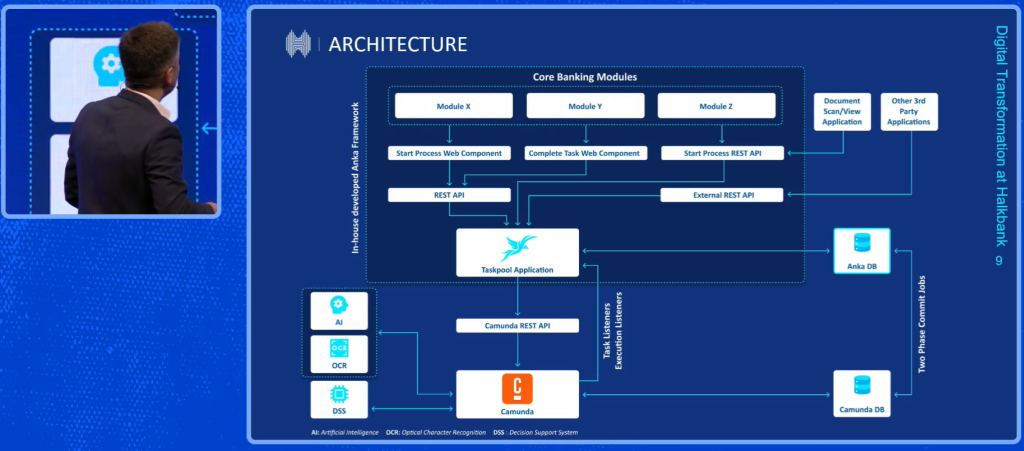
Küp went on to talk more about the challenges they had with their legacy systems and their efforts to digitally transform. Went it came to a process orchestration solution, they had key requirements, including following open standards, transparency, strong performance and the ability to operate in harmony with their existing Anka framework. Camunda was the solution that met these requirements, including the ability to work with a highly customized taskpool application.
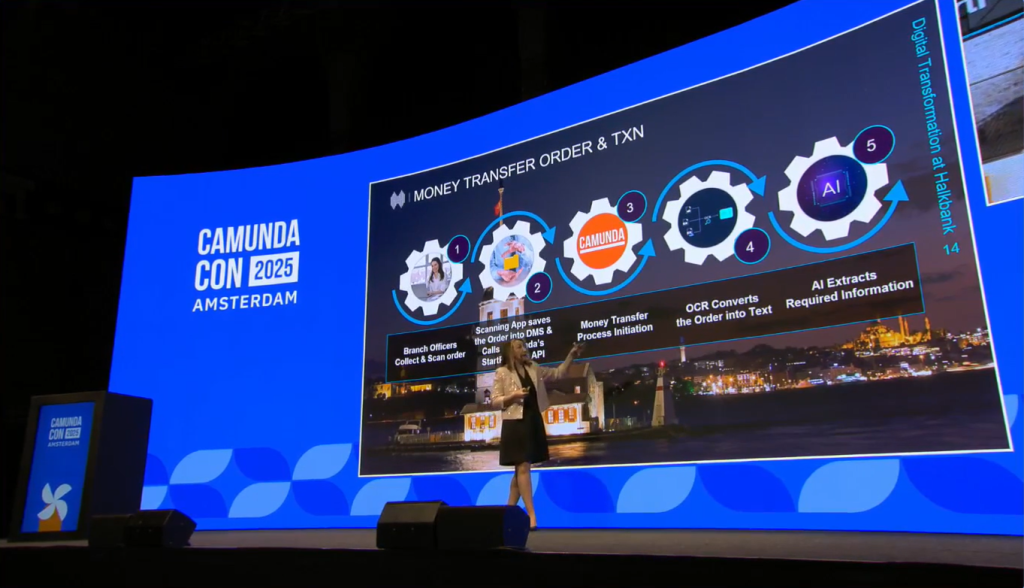
Money transfers are critical for banks but to come with challenges. Başaran detailed the process behind the 50,000 money transfer transactions Halkbank receives daily, the difficulties they have and how they resolve them. Using Camunda and AI, they were able to achieve some impressive results (see below), with 60% of transactions now completed with no human correction.
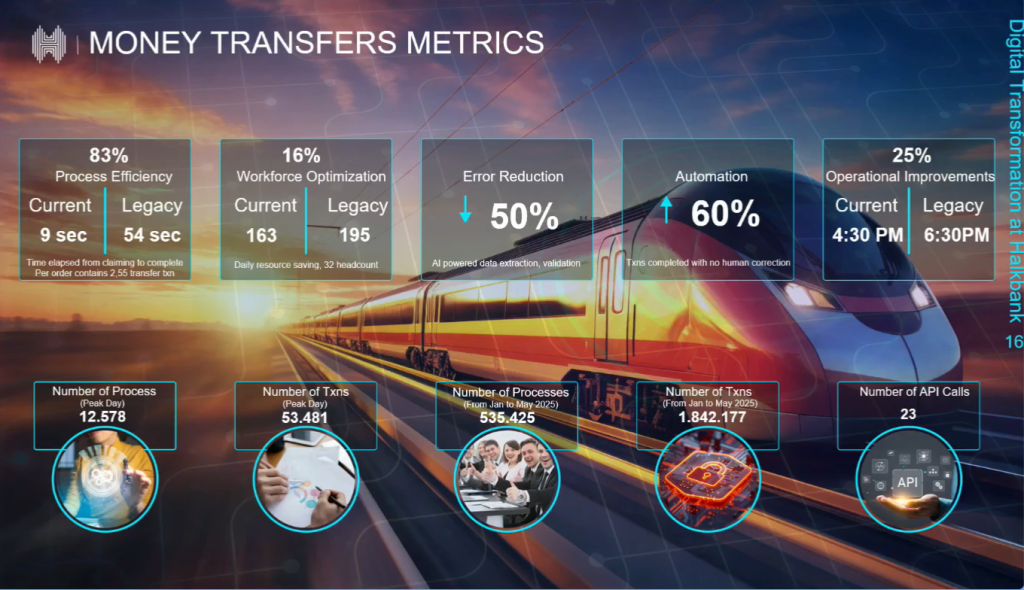
Başaran next shared some key takeaways, including that BPM is not a one-step journey and the benefits of improved business-IT integration. Küp closed the session with an overview of their migration plans to Camunda 8, which they are excited to do to gain horizontal scalability and handle higher volumes with faster response times.
ICYMI
- Scaling with Process Orchestration: Building a SAFe operating model with Camunda – In this session (not streamed but recorded), Learn how CityFibre and BP3 built a scaled agile framework (SAFe) IT operating model and integrated Camunda, which along with a CoE enabled them to scale effectively while enhancing operational agility and helping businesses thrive in fast-paced environments.
Business breaks
Next up for our in-person guests, we have our silent disco-style Business Breaks: Keeping Secrets: Mastering Secure Process Automation at Scale With Vault by Stefan Schultz and New Harbour: Transitioning Dutch pensions with Tiese Barrell and David Klein. For our online readers, this is a good chance to stretch your legs. We’ll see you back here shortly!
Tracking T-Systems Austria’s journey to Camunda 8 with myProcess Automation Platform
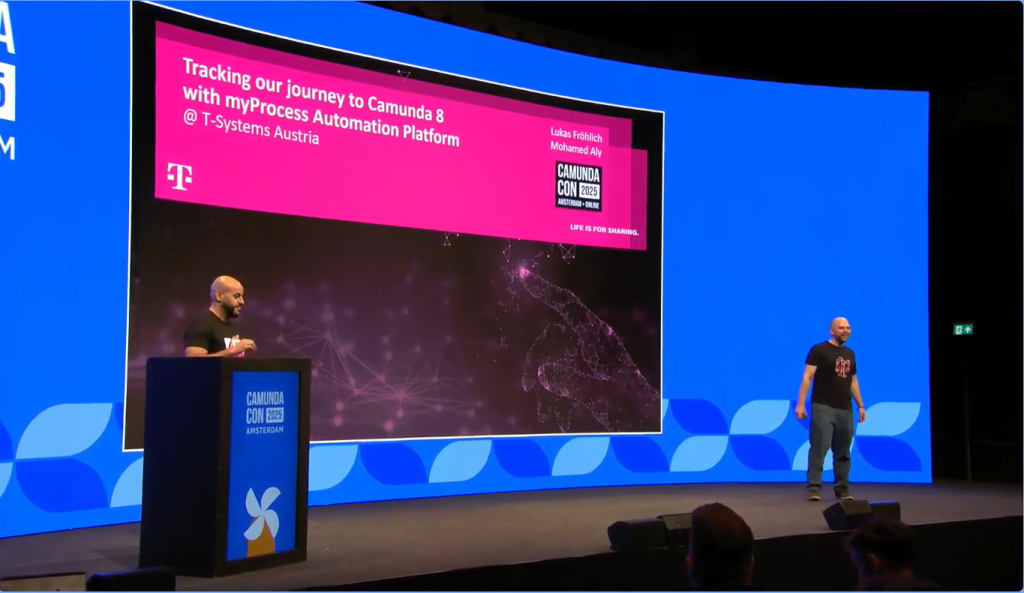
Lukas Fröhlich, Teamlead Automation at T-Systems and Mohamed Aly, Senior Solution Architect and Backend Developer at T-Systems joined us next to talk about their migration path to Camunda 8. T-Systems Austria is a subsidiary of T-Systems, a very large global IT services provider. In 2024 they had about 60,000 processes started and around 220 process definitions on Camunda 7 being managed by an automation team of 8, but there were many advantages to upgrading to Camunda 8—like the unified REST API, for example—and the team was eager to get started.
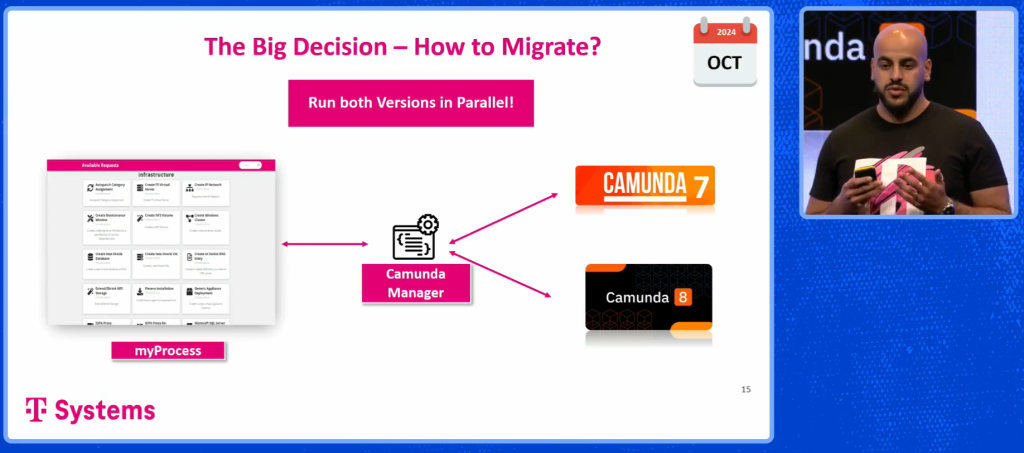
Aly spoke about how the initial approach—to migrate all processes and then turn off Camunda 7—was complicated due to the number of running processes they had in place. So they made the decision to run the two in parallel, enabling them to move faster and more safely by going one process at a time. Aly went on to describe various challenges in terms of infrastructure, versioning, topic limitations and more and how they overcame them. He also took us through the implementation in detail, including working with alpha versions and help received from Camunda support. Helpfully, the slides featured the month that each step was taken, giving us a great sense of the timeline here.
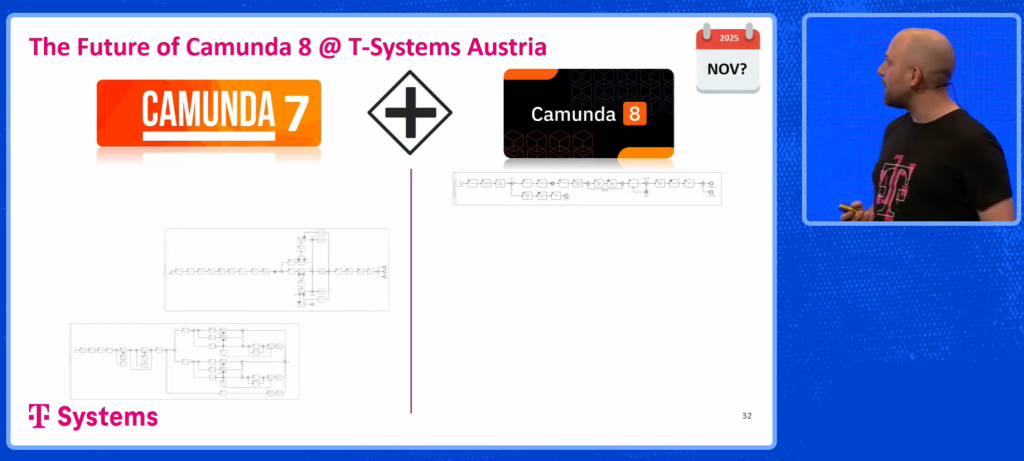
Fröhlich then led us through the final steps for the migration, including how they selected a meaningful use case to migrate and a demo that provides insight into how the use case is actually running in parallel and how it works in practice. While this is using an alpha version for now, he concluded with their plans to go to production with the next major release of Camunda in October, converting use case by use case (in the slide above, the use cases are moving to the right).
The Q&A session for this one had a lot of great questions as well. Don’t miss the full recording of this one for some amazing insights.
ICYMI
- Catching thieves with Camunda: A Rabobank FEC Tech story. In this session (not streamed, but recorded), you’ll learn how Rabobank uses Camunda to orchestrate key security processes in order to successfully fight financial crime and protect the bank’s customers and stakeholders. You’ll explore a crime-fighting process from inception to production.
Fast-Tracking Growth: Danica’s Digital Journey in Pension & Insurance with Camunda
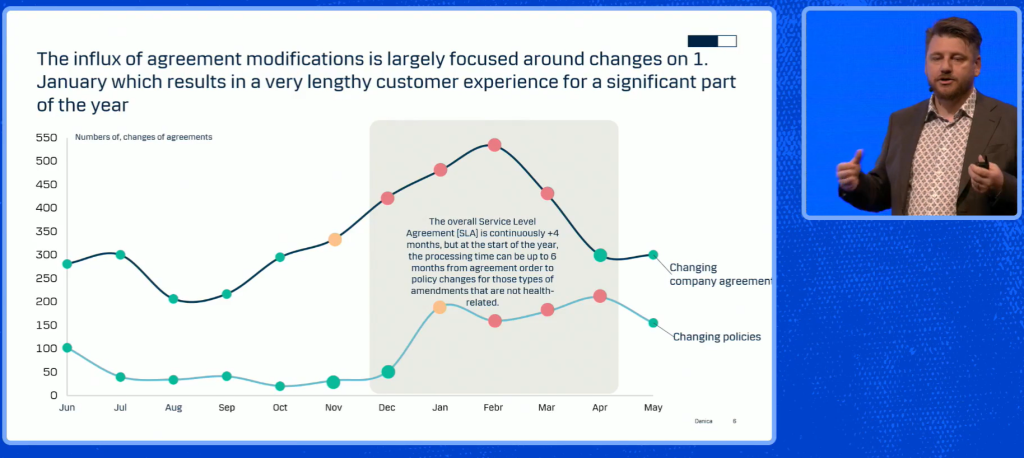
Danica, which is a subsidiary of Danske Bank with over 750,000 customers, was looking to embrace more automation and speed up its growth. Janus Kierkegaard, Head of Business Process Transformation at Danica, and Lee Kiew Seng, Head of Orchestration & Integration at Danica, took us through their story. A particular challenge they faced was a high level of demand every year on January 1st, which resulted in a large backlog that took them months to clear out. This was not an ideal customer experience and something they turned to Camunda to address.
Kierkegaard started by talking about the business problems, and how a big part of the solution was not just the technology, but about explaining the value Camunda could provide and getting other departments fully on board. This includes gaining a full understanding of existing business rules and processes and how they can be simplified and improved. They took it step by step and it got easier as they went (be sure to check out the slick Lego animation in the slides that demonstrates this 🧱).
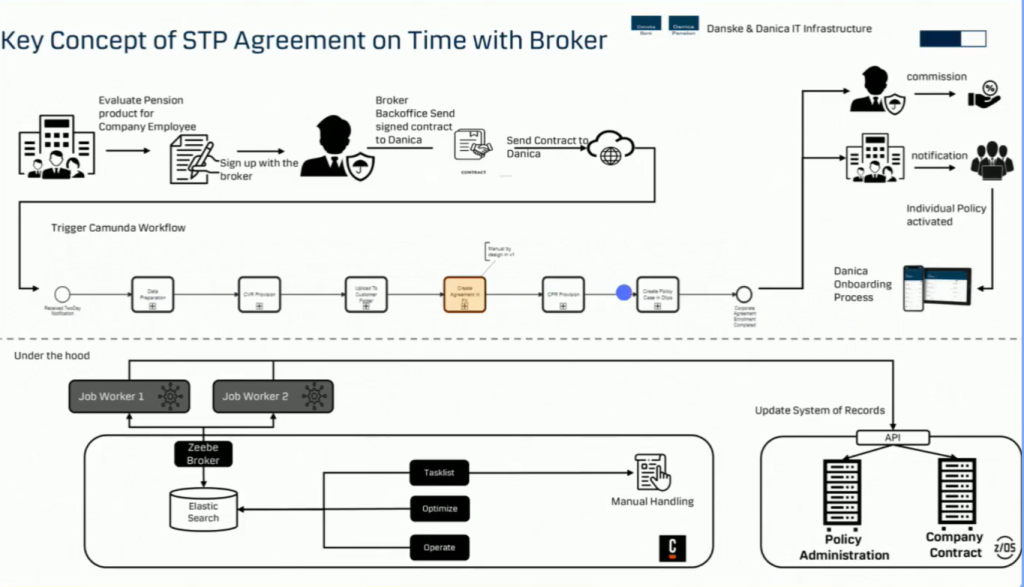
Lee Kiew Seng then explained on a more technical level some of the advantages Camunda provided them. I can’t capture them all here, but there are quite a few fascinating slides and demonstrations of the BPMN flow in action, so don’t forget to check out the full recording to see the full details.
And what’s next for Danica? They want to reimagine the health care and claim process target solution with Camunda and AI. They’re excited for the impact this can have in 2025 and beyond. They also shared their lessons learned from both the business and IT side. There are sure to be helpful insights in this talk no matter your role.
ICYMI
- Navigating a complex transition: Migrating business workflows from Camunda 7 to Camunda 8 in financial services – Marcin Osiecki, Senior Director / Distinguished Engineer at BNY, explained challenges faced when migrating workflows from Camunda 7 to Camunda 8 in a highly regulated industry like financial services. See how BNY met these challenges to support long-running processes, meet audit requirements, and provide resiliency and reliability. If you weren’t there in person, don’t miss the recording of this event.
Elevating Agentic Orchestration: How Camunda Partners Address Real-World Challenges
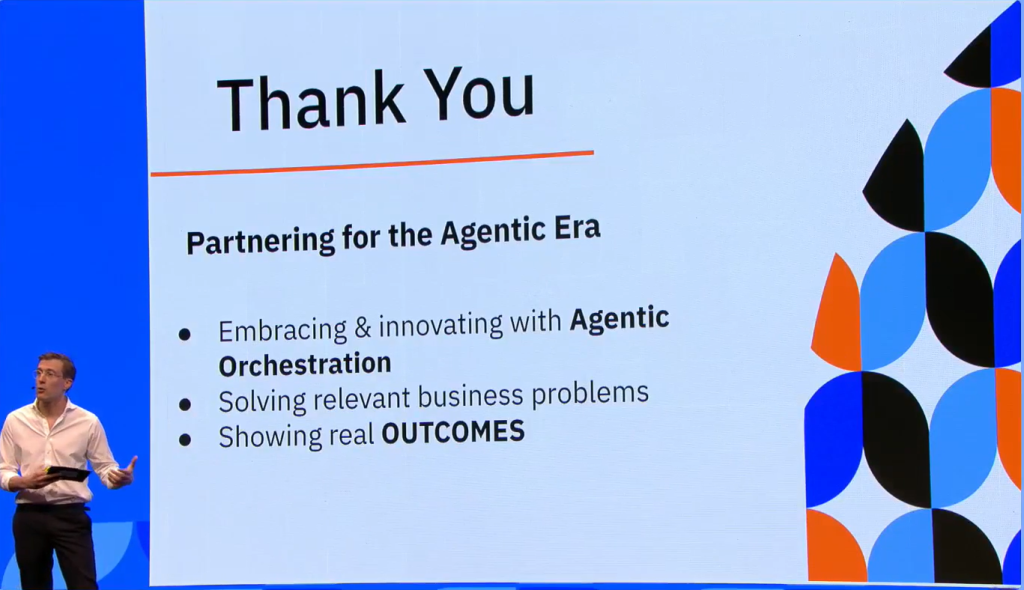
Frederic Meier, SVP, Sales at Camunda led off the next session by recapping the importance of agentic orchestration and how it can address concerns around using AI in truly critical processes by providing guardrails to help harness the dynamic value of AI. He then announced the launch of a programmatic approach to release new agentic orchestration solutions co-built by partners quickly. He invited all partners to participate and was excited to showcase several in this talk.
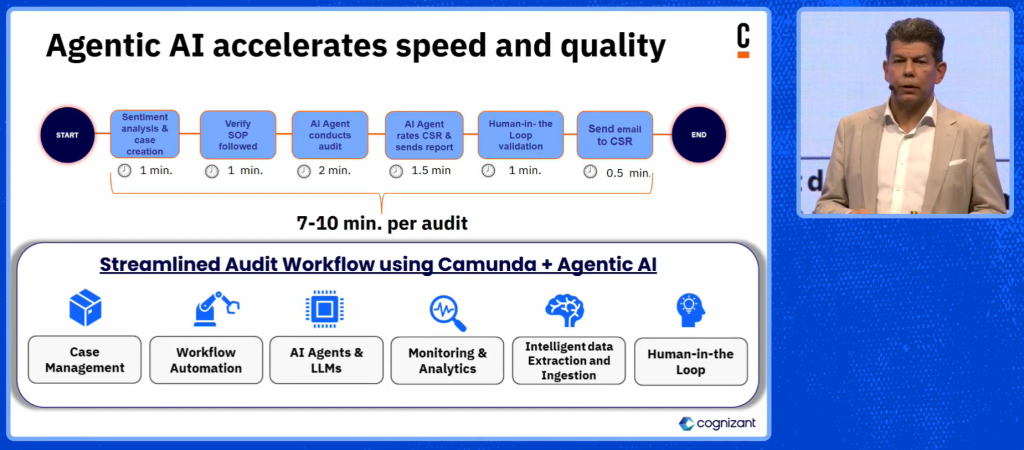
Frederic welcomed Erwin van der Horst, Northern Europe Commercial Leader, Process Orchestration and Enterprise Integration at Cognizant, to the stage next to talk about a solution that Cognizant has delivered for agentic AI-assisted quality auditing. Previously, auditing a support would 138 minutes per audit on average. A demo showed how this time can be reduced to 8 minutes per call, allowing for full auditing of calls rather than the spot-checking that is currently standard practice. He cited a 40-60% reduction in audit cycle time, 20-30% increase in auditor productivity and 30-50% reduction in overall costs.
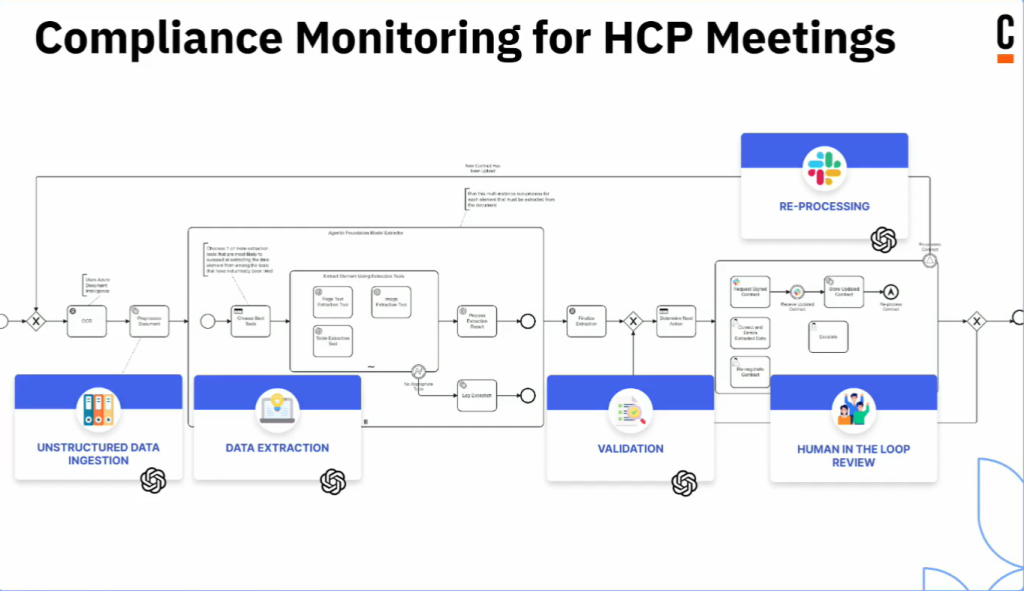
David Brakoniecki, Chief Delivery Officer at BP3 joined us next to talk about how agentic AI can impact compliance monitoring use cases by taking the example of Health Care Professional meetings. He talked about the challenges of compliance, which is often underfunded despite the growing complexity of the compliance landscape—at least, until there is a costly issue. It is also extremely manual and expensive. Brakoniecki highlighted how AI (paired with guardrails around DMN/BPMN) can get us from auditing a sample to true monitoring, and take a lot of low-value work off the hands of expensive compliance officers.
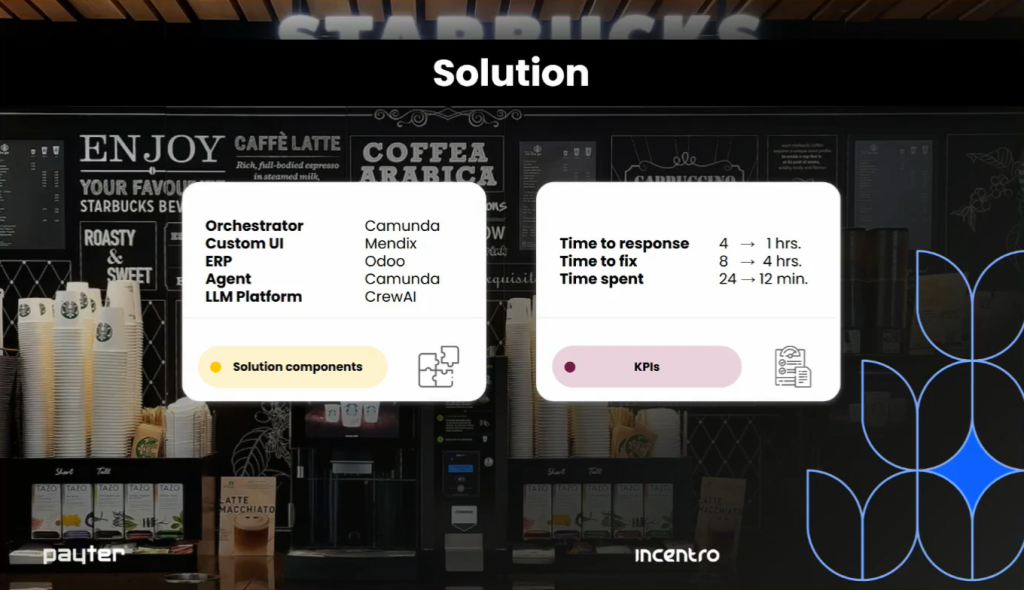
Next up, Edwin Nooijen, Partner Manager at Incentro, took the stage to talk about Payter’s unattended payment terminals (which was touched on back in the keynote) and how Incentro was able to help them. This included a great video demo (pictured in the keynote) showing how they significantly decreased time spent by customer support on each problem, and significantly sped up the time to a response at the same time, leading to vastly improved customer service and NPS values (not to mention happier employees).
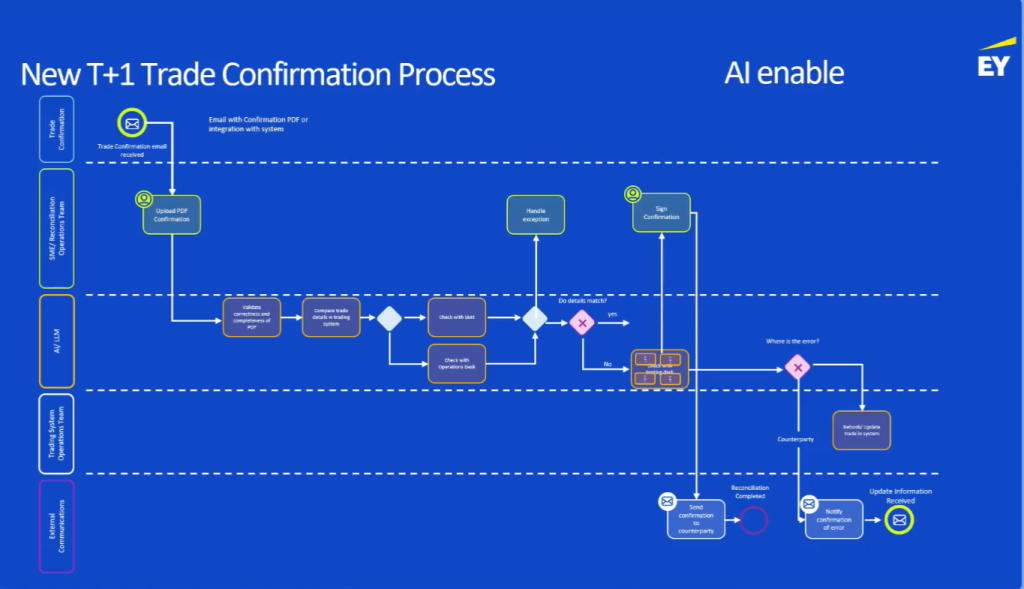
Lars Tandrup, Partner/Principal at EY stepped up next to discuss the solution EY has built using agentic orchestration to make trade reconciliation easier and faster. This is also a solution that was touched on back in the keynote, and Lars was excited to be able go into more detail here. The reconciliation process right now is extremely manual, and employees tasked with this typically only resolve 6-10 cases per day. EY reimagined the process to see how much manual work you could pass off to an AI agent, shifting the majority of the process (see the center swimlane in the slide) away from manual user tasks towards automation. The result is a 7x boost in the number of cases an employee can handle and a huge drop in costly errors.
ICYMI
- Streamlined impact: Building and maintaining media supply chains with Camunda 8 – Tom Oellerich, Product Owner Media Supply Chain at ZDF Studios talked about how to navigate the complexities of international content distribution, which is crucial amidst the ever-present “Streaming Wars.” Discover how ZDF Studios builds and streamlines its cloud based media supply chain with Camunda 8, achieving flexibility and control over their program catalog while minimizing technical maintenance. Recording will be available.
- Our journey from Custom Engine to the Camunda 8 Universe – Jan Philipp Piekuszewski, IT Product Manager Business Process Automation at Hapag-Lloyd AG and Monika Sane, Process Performance Manager at Hapag-Lloyd AG spoke about the strategic journey Hapag-Lloyd is on to enhance its process automation capabilities, aiming to move from a custom-built engine to an advanced, scalable solution that extends across systems. Explore their migration path from that custom engine to Camunda, the architectural foundation built on self-hosted Camunda 8, the the business value through process analysis in Optimize, and more. Recording will be available.
Aftershow, Exhibition & Networking
That’s it for today! In-person attendees are now off to an aftershow for snacks, drinks and a chance to talk more with fellow attendees and speakers. Don’t forget to tune in tomorrow, either to the live stream or to the day two live blog (or both!). And for those of you in Amsterdam who are brave enough, don’t forget about our traditional morning run with Bernd and the Camunda Team 🏃♂️🏃♀️💨.
If you’re in person, be sure you don’t miss the platform mastery series, industry round tables, the unconference and more tomorrow morning (local time) before the livestream kicks off with the keynote from Camunda co-founder and Chief Technologist Bernd Ruecker and Bastian Körber, VP Product Management at 12:30pm CEST / 6:30am ET. See you all then!
Update: CamundaCon 2025 Amsterdam has ended, but you can check out the videos (when available) so you don’t miss a thing!
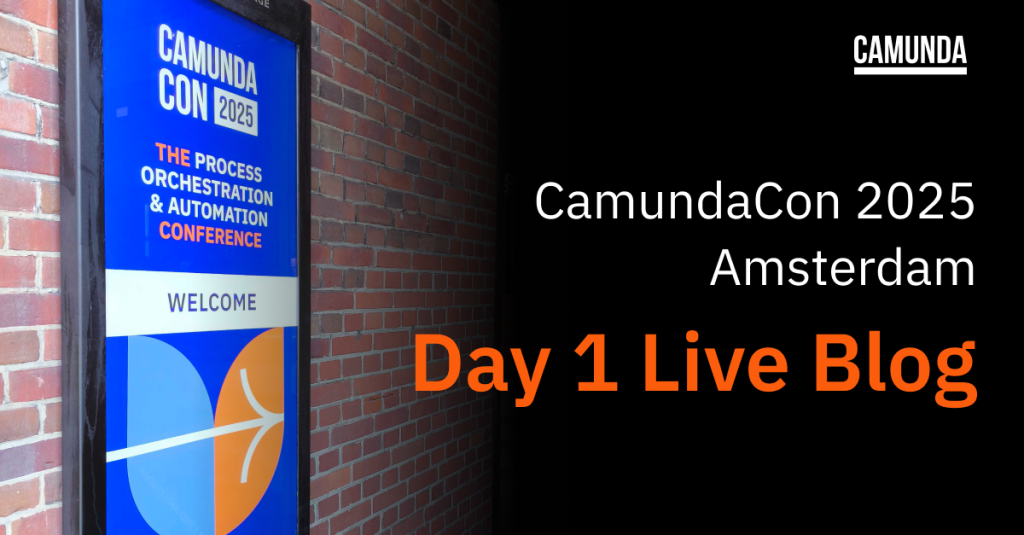


Start the discussion at forum.camunda.io